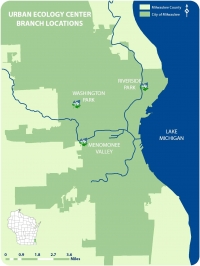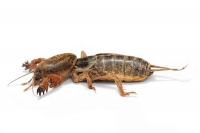
Research Highlight: Green Birding Challenge
Spring migration is one of the Research and Community Science Team's favorite times of year. For the fourth year in a row, we are hosting our Green Birding Challenge (GBC), the Team's signature annual fundraiser! Do you enjoy spending time outdoors hiking or biking, or just sitting and listening to the sounds of nature? If so, this year's GBC, held on Saturday, May 10th, is the event for you! Get out your walking shoes, dust off your lawnchair or pump up your bike tires and participate in a little competitive birding. Register a team for one of our four challenges: stationary birding, birding on foot, birding by bike, or a mini-challenge. Your participation will help us celebrate International Migratory Bird Day and help raise money for bird conservation and community science!
Research Highlight: GIS and Mapping
A recent NPR segment on All Things Considered reported some sad news - but brought the acronym “GIS” to light. The father of GIS (geographic information systems), Roger Tomlinson, passed away in early February. He was the first person to devise a computer software to overlay different types of map layers on top of one another, thereby efficiently revealing physical and biological patterns in a landscape or area and streamlining analyses of these patterns. Using current GIS software, the Urban Ecology Center has been able to map a variety of data about our branches and parks.
Native Animal of the Month - The Ant Lion
During our recent bout of sub-zero weather, I noted the shortage of wildlife in my backyard. I knew that woodchucks were hibernating in cozy burrows, birds had insulating feathers, and turtles used anti-freeze in their blood to get through the winter, but then I considered our spineless friends. Surely all of Earth's 1.3 million invertebrate species couldn't move inside for the winter. But, where did they go? This question made me think about one bug in particular; one that I commonly associate with the warm weather. The antlion. What was my old buddy Mr. Ant Lion up to this time of year?
Native Animal of the Month - Aerial Yellowjacket
As the seasons change from autumn to winter, my field work tapers off and I spend most of time behind a computer, analyzing data and determining what can be accomplished the following field season. During this period our bird walks become my favorite time of the week. The walks give me some personal time to identify with nature be outside. However it isn’t the birds I enjoy the most, it’s the other discoveries. I like finding the overlooked, under-appreciated things that just seem beautiful and you can't really explain why. This week, my favorite find came while I was on a bird walk in the Menomonee Valley.
Research and Citizen Science: Gear Shift
October marks a bittersweet time in the annual cycle for the Research & Community Science crew. Summer is over, and along with it, go the warm temperatures, lush vegetation, and abundant wildlife. Many animals are starting to head south for the winter or are making their way toward hibernation areas. Additionally, we have come to the end of our 3-year Great Lakes Restoration Initiative (GLRI) research and restoration grant from the EPA that helped create the Milwaukee Rotary Centennial Arboretum. On the bright side, it's now the time to process the variety of data we have collected over the past three field seasons and start looking for trends or changes!
Native/Non-Native Animal of the Month - Mole Cricket
One of my favorite parts of summer is the unique sounds of insects and in particular the song of the mole cricket. Many people confuse the mole cricket’s song with that of a frog, however, its staccato repeated chirps undeniably belong to an insect. The song’s frequency is very low for a bug and is known to be the lowest of all of the crickets.
So There Are Bats in Riverside Park...But What Do They Do?
We know there are bats in Riverside Park. Hike a trail at dusk and you may see a Big Brown Bat fly overhead or even hear a few chirps if a bat is closing in on its prey. Because of their nocturnal aerial habits, bats make very difficult study subjects. But recent technological advances are allowing us more detailed glimpses into the habits and distribution of Wisconsin’s bats, including those in Riverside Park.
Research & Citizen Science Highlight: Lichens!
Lichens are the ultimate example of collaboration in the natural world. If you're not familiar with this group of organisms, perhaps this joke will clue you in: Why did the fungus and the algae get married? Answer: They took a lichen to each other! If you've heard this joke before, you're probably groaning and rolling your eyes. If you haven't, I hope you're intrigued.
Native Animal Spotlight - The Common Green Darner Dragonfly
The Common Green Darner (Anax junius) is a lovely migratory dragonfly that visits Wisconsin from April through September. This native invertebrate is Wisconsin's most common large dragonfly. The male has a bright bluish-green abdomen and is sexually dimorphic from the female whose abdomen ranges from brick-red to bluish gray. They have four gossamer wings, heavy thoraxes and are about the size of hummingbirds. They are extraordinary fliers; flying forward, backward, while mating and even while laying eggs! Their flight is so incredible that aeronautic scientists have studied them to better understand flight physics.
Citizen Science Spring Workshops
The Center's program is really hopping (and swimming and wriggling and flying)! We are monitoring everything from mammals to frogs to moths. We need you! If you are interested in becoming a community scientist and helping us collect data in the park or analyze that data, please attend one of the monitoring workshops listed below. All of the workshops are free and are held at our Riverside Park branch.
Copyright © 2023 The Urban Ecology Center












